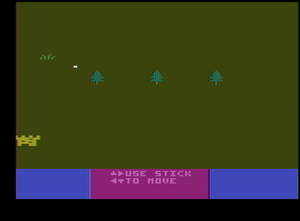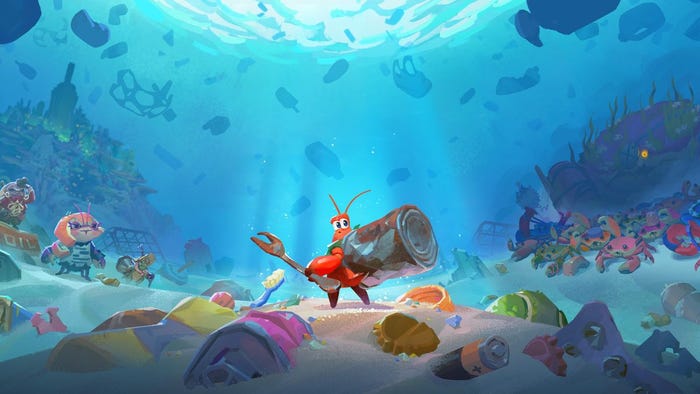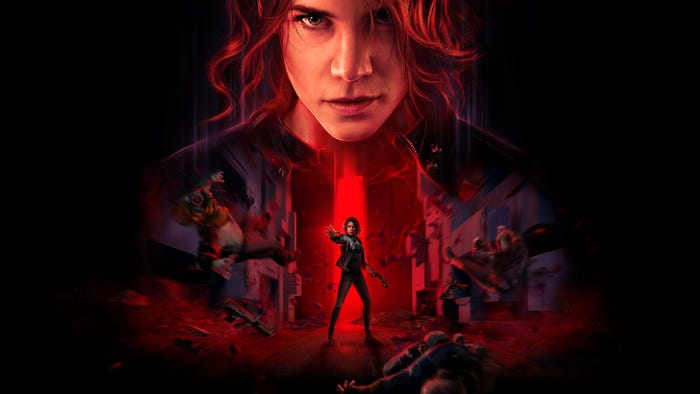
Featured Blog | This community-written post highlights the best of what the game industry has to offer. Read more like it on the Game Developer Blogs.
Atari VCS: Dragonstomper
Another excerpt from the VCS book, this one covers the early RPG Dragonstomper, which has some amazing features for 1982! Anyone interested in the early history of CRPGs needs to take a look at it.

[This is an excerpt from '21 Unexpected Games to Love For The Atari VCS', available for two more days in the current game eBook Storybundle, which covers a number of classic VCS games that, untethered from nostalgia, may still be of interest to a player who didn't grow up with the system. The game covered here is not only, amazingly, a full RPG for the VCS, released in 1982, but it's got some modern features! For comparison, Ultima I was released in 1981.]
Dragonstomper
1 player, joystick. About 25K in size.
Created by Stephen Landrum. Published by Starpath in 1982 for the Supercharger add-on.
Accessibility: 3/5
In a sentence: Supercharger owners in 1982 could play this remarkable RPG, a journey with three major phases, an overworld to explore, a final monster encounter with multiple ways to beat it, and randomized items.
 The Supercharger
The Supercharger
A company called Arcadia, which later changed their name to Starpath, produced an unusual peripheral for the VCS called the Supercharger. Operating on the same principles as the popular Datasette tape drive for 8-bit Commodore machines, it allowed the distribution of VCS games on ordinary audio cassette tape. The Supercharger had a quantity of RAM for loading games from tape (the user would have to supply an ordinary tape player for that), which after loading would be visible to the VCS' process as if it were ROM. Not only was the Supercharger's 6K of RAM much larger than most VCS games by itself, but games could also be made "multiload," carrying over state and variables from previous program segments on the tape into new ones.
This scheme allowed for games of much greater complexity than the standard VCS software. Some Starpath games rivaled computer games from the time for complexity. All that RAM also made the Supercharger a pricey add-on, at $70. Not a huge number of games were made for it, but a few are something special.
The Game
 It really doesn't take a lot of program space to make a RPG.
It really doesn't take a lot of program space to make a RPG.
What is an RPG anyway? You have a character, with some kind of statistics, who explores an area, solves puzzles, interacts with NPCs and fights opponents. Some of these aspects may be missing depending on the system, scenario and style of play, but back in the early 80s most games tended to hew fairly close to the template established by D&D.
At the core of these kinds of RPGs is a conflict resolution system. The system decides how hard a thing is numerically, generates a random number, and compares them. Simple random numbers can be generated with just a few instructions, difficulty can be determined with a look-up table of the threats the player could face, and the compare then branch instruction is a simple four or five bytes after that. It's all simple arithmetic, which computers are great with. This persists even with modern CRPGs; a 3D engine might require matrix transformations and Z-ordering and normal mapping, but the procedural underpinnings of the gameplay will rarely be more complex than what Dragonstomper did back in 1982.
I've noticed two particular kinds of games for the Supercharger. Those that use the expanded space for better graphics, and those that use it for greater complexity. In the former category there's the excellent "The Official Frogger," which performs the trick of actually being better than the great Parker Bros. adaptation, which was good enough to make it one of the best-selling games for the console. In the latter, well, there's Dragonstomper. No one could claim that it has excellent graphics, but it's the use to which they are put that makes the game.
The game begins with you in the middle of a sparsely-populated field. On the negative side, the field is mostly empty space with some interesting locations scattered around. On the positive, the field scrolls smoothly, in any direction. All the contents of the field are sprites, you see, or "players, missiles and a ball" in VCS lingo, so they can go wherever the programmer wants them to go. They simulate a map roughly 16 times the size of the screen. Some of the things are just terrain, like trees, swamps, grasses and a big pit. The random encounters generated depend on where your character currently is, so if you're looking to fight spiders, look in the plains, whereas you're more likely to find monkeys in the trees.
Fights are, unusually for VCS RPGs, entirely numbers-based. There is no action component to them. Instead, on your turn, you pick from a menu of options: Move (that is, escape), Fight (attack the enemy), Use (an item) or Status, which doesn't consume a turn and is the only way to check how much health (or "Strength") you have. Interestingly, it's possible to encounter enemies in multiples, which is one of those little unexpected touches that Dragonstomper abounds with. You can also call up the menu outside of battle, by pressing the joystick button, in case you want to check status or use an item at another time.
Some other locations include castles, churches or huts. Some you can just walk into, but others require that you have a key to unlock them, obtained from fighting random monsters. When you walk into such a place on the map, the action menu again appears at the bottom of the screen for your response. Thankfully, you don't have to memorize a complicated set of controls for this game; the menu reminds you what each direction does! It's perhaps the best way to condense the controls of an old-school CRPG into a controller with a single button that's possible. You don't have to fuddle with the Difficulty or Color/B&W Switches, or plug in a second controller, or anything. The game plays just about as smoothly as possible, which is amazing all by itself.
To unlock one of these places, you walk into it, select Use from the action menu, then go through the list of carried items (press Down to page through it) until you find a Key, which is consumed in its use. Fortunately, you can carry more than one of each item.
 In some locked locations are monsters to fight, and when defeated they may leave you another item. There's a good variety of these items, and some of their functions are mixed up each game. Some experimentation will help you figure out what is used for what on this play. Most of the items will tell you that they make you feel "weird," but check your statistics (Down from the action menu) before and after using and note any differences. As I said before "Strength" in the Status screen is actually your hit points. When you get hit in battle it decreases, and the game ends when it reaches 0. You heal slowly over time, but the chance of random monster attacks makes relying on that risky. "Dexterity" there appears to be your general combat strength. It can be decreased and increased too, but the ways that's done are more obscure.
In some locked locations are monsters to fight, and when defeated they may leave you another item. There's a good variety of these items, and some of their functions are mixed up each game. Some experimentation will help you figure out what is used for what on this play. Most of the items will tell you that they make you feel "weird," but check your statistics (Down from the action menu) before and after using and note any differences. As I said before "Strength" in the Status screen is actually your hit points. When you get hit in battle it decreases, and the game ends when it reaches 0. You heal slowly over time, but the chance of random monster attacks makes relying on that risky. "Dexterity" there appears to be your general combat strength. It can be decreased and increased too, but the ways that's done are more obscure.
Your primary goals in this overworld are:
To build up money and items you can sell. Your success in the dragon's cave, the final third of the game, depends on how far you build your character up in this portion, and that mostly means collecting money.
To keep your Strength and Dexterity up, and to build up their maximums.
To find a way to get by the Guard to the town that's part two of your quest, and ultimately the way to the dragon's cave.
After the overworld you have to find your way past a guard into a village, and from there get through the Dragon's Cave, but a lot of the fun of this kind of game is figuring out how the game works for yourself, so I'll leave that for the Notes section.
Let's note the number of interesting features Dragonstomper has:
Two large scrolling areas, an open overworld and the dragon's cave.
A complete menu system navigated with one joystick and its single action button.
A full inventory system, with items that can be used or dropped.
Some item functions are randomly determined from game to game.
Hirelings that can be brought on to help with the final battle.
Hidden traps, and ways to detect those traps.
A good variety of opponents in the overworld, generated based on the terrain the player is traversing.
Locked doors and chests, and randomly-found keys to open them with.
Players can either beat up the guard blocking the way to town, or find another way past him.
Players can defeat the dragon at the end in a variety of ways, including destroying the amulet that makes it evil and resolving the encounter peacefully.
 It's ahead of its time in so many ways. Ultima I, the beginning of the long-running series that inspired a large portion of the CRPG industry, was released just the year before. The idea that a CRPG could support multiple solutions to major obstacles itself is an idea that doesn't seem to have really taken hold elsewhere until Wasteland, several years later.
It's ahead of its time in so many ways. Ultima I, the beginning of the long-running series that inspired a large portion of the CRPG industry, was released just the year before. The idea that a CRPG could support multiple solutions to major obstacles itself is an idea that doesn't seem to have really taken hold elsewhere until Wasteland, several years later.
Notes
A lot of the challenge of Dragonstomper is in figuring out the rules of the universe. The manual explains almost nothing about the many items there are to find. Complicating matters, some items have a randomized function that changes every game. If you work to discover all this on your own, you'll get several hours of play time out of Dragonstomper before your first win, and that will usually come after a lucky streak. The rest of these notes are helpful information about how to play the game, all of which could be considered to be spoilers if you're a purist. You've been warned....
First, you are vulnerable to random monster fights even when idle in the countryside. If you want to pause the game, press the button to open the menu.
The primary setting of the game is the countryside, there you build up your character for the rest of the game. You try to gain Strength, maximum Strength (a hidden statistic) and Dexterity there, while saving up money to fund your venture in the Village. When you're ready, you'll have to find a way to get past the Guard of the bridge leading to the Village. There, you will sell excess inventory, then buy the items you think you'll need from the stores there. You can also hire help with which to take on the Dragon. Finally you enter the Dragon's Cave and survive the traps of the path leading to the Dragon's Lair, a pit in the ground.
The Churches on the map will heal you if you pay them money. If you pay 200 they'll heal you completely, or at least by a large amount. If you pay 15, you'll only get healed for one Strength point. Prayer doesn't seem to do anything.
There are five kinds of random items you can find in the countryside: Potions, Crosses, Rings, Charms and Staves. When the game begins, their functions are selected from Gain Strength and Gain Max Strength, Gain Dexterity, Lose Half Strength, Lose Dexterity and Reveal Traps. But, although their functions are different each game, the methods by which they appear remain mostly the same. Potions are fairly common, Crosses will sometimes be given to you at a Church, a Charm is sometimes given at a particular Temple, and Rings are random monster drops. Staves are special; the only way they get generated is as random drops from Slimes. All these functions provide the same "feels weird" message, so you'll have to actually check your status before and after using items to narrow down their functions. Some trial and error is necessary to figure out what is what, but try not to use the stat-losing items more than once. Especially the Dexterity-losing item; if the Dex-gain item ends up being Ring, Charm or (heaven help you) Staff, you'll be in for a difficult time. None of these items will work in the Dragon's Cave.
The flashing Castle contains the Paper, which is an important item. On the other hand, the Shield you get from a Temple serves only to give you a one-time boost of 5 Dexterity points when you gain it. Handaxes can be used in battle, and are the only item you gain in the Countryside that can be used in the Dragon's Cave.
When you get to the Village you'll have to again figure out what the items do. Fortunately these are the same every game, but you still have to learn their functions that first time. You should at least know this: Vitamins restore all your Strength, Elixirs increase your Dexterity by a small amount, and Medicine cures poisoning. The rest of the items are a bit more obvious; if you want to know more, check the FAQ in the links section. Note that the magic spell scrolls you can buy all have a random chance of not working.
 One of the interesting aspects of the game is that there's multiple solutions to some of your problems. The guard blocking the way into the Village can be overcome in at least three different ways. The final Dragon encounter is fairly memorable; several strategies will work, including one (which the manual hints at) in which you don't kill the Dragon at all! Try different items in different circumstances and see what you can discover.
One of the interesting aspects of the game is that there's multiple solutions to some of your problems. The guard blocking the way into the Village can be overcome in at least three different ways. The final Dragon encounter is fairly memorable; several strategies will work, including one (which the manual hints at) in which you don't kill the Dragon at all! Try different items in different circumstances and see what you can discover.
Finally, if you happen to die while still in the Countryside, you can press Game Reset to revive your character. You'll be back to your starting stats and gold and lose all your other items, but the random items will have the same functions.
Links
AtariAge - Manual - Hint Sheet from AtariAge forums, written by shadow460
The CRPG Addict, who aims to write up every CRPG ever published, covered Dragonstomper as game #118.
Hardcore Gaming 101 doesn't generally review VCS games, but it does have a good page on Dragonstomper.
Dragonstomper has some surprising advocates, including a columnist for Forbes Magazine (Wayback link).
There's not much on the game in the way of FAQs, but the ever-helpful Wayback Machine has an archive of one. There are some errors in it though; the price to hire a Warrior is known to decrease if you're low on money, and there is a use (a very nice one!) for the Unlock spell.
Also try...
The other Supercharger adventure games, one, Sword of Saros, is covered in this book.
Read more about:
Featured BlogsAbout the Author(s)
You May Also Like









